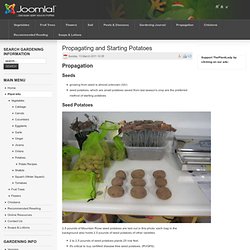

How to Prune Your Cucumbers to Grow them Vertically up a Trellis. Tomatos. Growing Your Own Garlic - Planting Growing Harvesting and Storing Garlic. As far as I'm concerned, garlic gets the blue ribbon for growing your own.

It's absurdly easy to plant and care for; it tastes great; it looks beautiful and it takes up so little ground that even those with very small gardens can raise enough to be self-sufficient in garlic for a good part of the year. All you have to do is choose the right varieties; plant at the right time, in the right soil; then harvest when just right and store correctly. 1. Choosing Types of Garlic If you look in a specialist catalog like the one at Gourmet Garlic Gardens, you'll find dozens of varieties of garlic listed. You see where this is going – and you can see a lot more types of garlic on either of those websites, but for general purposes the most important difference is the one between softneck and hardneck.
Softnecks are so called because the whole green plant dies down to pliancy, leaving nothing but the bulb and flexible stems that are easy to braid. Gardeners in most of the U.S. can try some of both. 2. Growing your own: Pumpkins & winter squashes. Sow: April Plant: May - June Harvest: July - October Recommended varieties "For winter squash try Uchiki Kuri or Onion Squash," says Charles Dowding.

"They crop reliably, producing small, bright-red fruit in September and keep until Christmas. Sowing and planting Winter squashes and pumpkins need a long, hot growing season to ripen. Cultivation As with courgettes and marrows, the plants can have their trails pinned round in circles or guided with sticks to save space. Pests and diseases Pumpkins are unfortunately the favourite dish of many bugs, including the cucumber beetle, which carries a disease that can lead to a powdery mildew developing. Harvesting If you want to use your veggies fresh, pick them when they reach the required size. Storage Cure the skin by exposing your crop to the direct sun for about 10 days. Vegetables. Propagating and Starting Potatoes. Sunday, 13 March 2011 10:35 Seeds growing from seed is almost unknown (GV) seed potatoes, which are small potatoes saved from last season's crop are the preferred method of starting potatoes Seed Potatoes 2.5 pounds of Mountain Rose seed potatoes are laid out in this photo; each bag in the background also holds 2.5 pounds of seed potatoes of other varieties 2 to 2.5 pounds of seed potatoes plants 25 row feet. it's critical to buy certified disease-free seed potatoes.

(RVGPS) the flesh of the seed potato is the food that will fuel the plant growth for up to 3-weeks (RVGPS) tubers left in the ground will often sprout the next year, however this isn't advisable, as they tend to become diseased. Chitting 2.5 pounds of Mountain Rose and 2.5 pounds of German Butterball seed potatoes laid out for chitting Note: I shouldn't have cut them before chitting them.
Chitting seed potatoes shortens the time between planting and harvesting. Saving Seed Stock Microplants Cuttings Division. Guide to Growing Vegetables. Some general considerations for growing vegetables: Sowing Tips When sowing seeds, a good general rule of thumb is to sow to a depth of approximately twice the thickness of the seed.

Some smaller seeds require light to germinate and should not be sown too deep; otherwise they may never germinate or break through the surface of the soil. Conversely, large seeds planted too shallow may not develop properly. Keep seeds well-moistened while awaiting germination and check regularly. Select a light-weight, well-drained medium for sowing to ensure good seed to soil contact. Growing Tips Most vegetables will produce better results if sown and grown in a soil-medium that is well-drained, rich in organic matter (fertile), and fairly lightweight. Most vegetables will prefer good quantities of natural, direct sunlight daily.
From Zero to Vegetable Garden in 6 Months - Tips So You Can Succeed. Vegetable Garden. How to Grow 100 Pounds of Potatoes in 4 Square Feet. On many occasions, we've been tempted to grow our own potatoes.

They're fairly low maintenance, can be grown in a pot or in the ground, last a fairly long time if stored properly, and can be very nutritious (high in potassium and vitamin C). Here's more incentive: according to this article, you can grow 100 pounds of potatoes in 4 sq. feet. Learn how after the jump... According to this article from the Seattle Times, potatoes planted inside a box with this method can grow up to 100 pounds of potatoes in just 4 square feet.
All that is required: Lumber Seed potatoes Soil Careful attention to watering The Times' guide for building a potato growing box yields up to a 100 lbs. of potatoes in a mere 4 square feet is shown below: Plant as early as April or as late as August 1, with an approximated 3 month till harvest turnaround time. Here are some pointers from the article: Cut apart larger seed potatoes, making sure there are at least two eyes in each piece you plant. Vegetable Garden. Greenhouse Supply.